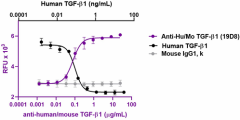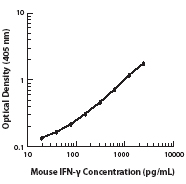- Clone
- 19D8 (See other available formats)
- Regulatory Status
- RUO
- Other Names
- Transforming growth factor-beta 1 (TGF-b1), TGFB1, CED, DPD1
- Isotype
- Mouse IgG1, κ
- Ave. Rating
- Submit a Review
- Product Citations
- publications

-

Recombinant human TGF-β1 (black circles, Cat. No. 781802) inhibits the proliferation of HT-2 cells induced by recombinant mouse IL-4 at 5 ng/mL (Cat. No. 574302). Ultra-LEAF™ Purified anti-human/mouse TGF-β1 antibody (purple circles, clone 19D8) inhibits the effect of recombinant human TGF-β1 (at 0.4 ng/mL) in mouse HT-2 cells in a dose-dependent manner; whereas the mouse IgG1, κ isotype control (grey triangles, clone MOPC-21, Cat. No. 400165) does not have effect. The ND50 = 0.04 – 0.2 µg/mL.
| Cat # | Size | Price | Save |
|---|---|---|---|
| 521707 | 100 µg | ¥39,350 | |
| 521708 | 1 mg | ¥123,340 |
TGF-β1 is a multifunctional cytokine that plays pivotal roles in diverse biological processes. TGF-β1 is synthesized as a 390 amino acid precursor that is cleaved by furin, localized in the trans-Golgi network, in residue 278. Furin processes the TGF-β1 precursor at the carboxyl side of the consensus sequence RHRR which precedes the NH2-terminal Ala 279 residue of the mature TGF-β1. The TGF-β1 precursor includes the latency-associated peptide (LAP dimer) in the N-terminal portion and the 25 kD portion that constitutes the mature TGF-β1 in the C-terminal. LAP dimer and the TGF-β1 mature protein remain non-covalently associated after furin cleavage and this complex does not bind to the TFG-β1 receptor. In addition, the TGF-β1 latent complex is joined covalently through LAP to LTBP. The TGF-β1 active form requires dissociation from LAP. Some activators can release TGF-β1 from LAP such as thrombospondin-1, reactive oxygen species, and the integrins avb6 and avb8.
Mouse TGF-β1 converts naïve T cells into regulatory T (Treg) cells that prevent autoimmunity. Although human TGF-β1 is widely used for inducing FOXP3+ in vitro, it might not be an essential factor for human Treg differentiation. Th17 murine can be induced from naïve CD4+ T cells by the combination of TGF-β1 and IL-6 or IL-21. Nevertheless, the regulation of human Th17 differentiation is distinct. TGF-β1 seems to have dual effects on human Th17 differentiation in a dose-dependent manner. While TGF-β1 is required for the expression of RORgt, in human naïve CD4+ T cells from cord blood, TGF-β1 can inhibit the function of RORgt at high doses. By using serum-free medium, it has been clarified that the optimum conditions for human Th17 differentiation are TGF-β1, IL-1b, and IL-2 in combination with IL-6, IL-21, or IL-23.
Product Details
- Verified Reactivity
- Human, Mouse
- Antibody Type
- Monoclonal
- Host Species
- Mouse
- Immunogen
- Human TGF-β1
- Formulation
- 0.2 µm filtered in phosphate-buffered solution, pH 7.2, containing no preservative.
- Endotoxin Level
- Less than 0.01 EU/µg of the protein (< 0.001 ng/µg of the protein) as determined by the LAL test.
- Preparation
- The Ultra-LEAF™ (Low Endotoxin, Azide-Free) antibody was purified by affinity chromatography.
- Concentration
- The antibody is bottled at the concentration indicated on the vial, typically between 2 mg/mL and 3 mg/mL. Older lots may have also been bottled at 1 mg/mL. To obtain lot-specific concentration and expiration, please enter the lot number in our Certificate of Analysis online tool.
- Storage & Handling
- The antibody solution should be stored undiluted between 2°C and 8°C. This Ultra-LEAF™ solution contains no preservative; handle under aseptic conditions.
- Application
-
Block - Quality tested
- Recommended Usage
-
Each lot of this antibody is quality control tested by blocking activity of human TGF-β1 (500 pg/ml) in Mv1Lu-(caga)12-Luc reporter cells. The ED50 is 0.05 - 0.1 µg/ml. It is recommended that the reagent be titrated for optimal performance for each application.
- Application Notes
-
ELISA Detection: To measure TGF-ß1, this antibody can be used as a detection antibody in sandwich ELISA format, and paired with the purified 21C11 antibody (Cat. No. 525301) as the capture antibody. Recombinant Human TGF-ß1 (ELISA Std.) (Cat. No. 580709) can be used as the protein standard.
Blocking: Clone 19D8 LEAF™ purified antibody (Endotoxin <0.1 EU/µg, Azide-Free, 0.2 µm filtered) is useful for in vitro blocking of human and mouse TGF-ß1 bioactivity. The 19D8 clone does not inhibit the bioactivity of human TGF-ß2 or TGF-ß3 in the Mv1Lu-(caga)12-Luc reporter cell assay.
Note: For testing TGF-ß1 in serum, plasma or supernatant, BioLegend's ELISA LEGEND MAX™ Kits (Cat. No. 436708 & 437708) are specially developed and recommended. - Product Citations
-
- RRID
-
AB_2810653 (BioLegend Cat. No. 521707)
AB_2810654 (BioLegend Cat. No. 521708)
Antigen Details
- Structure
- Homodimer
- Distribution
-
TGF-β1 is secreted by numerous cells.
- Function
- TGF-β1 influences the fate of T cells into different subpopulations depending on the occurrence of other cytokines. TGF-β1 induces cell growth and survival, cell and tissue differentiation, development, inflammation, immunity, hematopoiesis, tissue remodeling, wound healing, and stimulates ECM deposition and angiogenesis. It is an essential mediator of pathologic scarring in fibrotic disorders.
- Interaction
- Multiple cells express the TGF-β1 receptors.
- Ligand/Receptor
- Heterodimeric receptor consisting of type I (TbRI) and type II (TbRII).
- Biology Area
- Apoptosis/Tumor Suppressors/Cell Death, Cell Biology, Cell Cycle/DNA Replication, Immunology, Neuroinflammation, Neuroscience
- Molecular Family
- Cytokines/Chemokines, Growth Factors
- Antigen References
-
1. Dubois CM, et al. 1995. J. Biol. Chem. 270:10618.
2. Dennler S, et al. 1998. EMBO J. 17:3091.
3. Annes JP, et al. 2003. J. Cell. Sci. 116:217.
4. Zou Z and Sun PD. 2004. Protein Expr. Purif. 37:265.
5. Park SH, 2005. J. Biochem. Mol. Biol. 38:9.
6. Valcourt U, et al. 2005. Mol. Biol. Cell. 16:1987.
7. Mucida D, et al. 2007. Science 317:256.
8. Acosta-Rodriguez EV, et al. 2007. Nat. Immunol. 8:942.
9. Puthawala K, et al. 2008. Am. J. Respir. Crit. Care Med. 177:82.
10. Takatori H, et al. 2008. Mod. Rheumatol. 18:533.
11. Manel N, et al. 2008. Nat. Immunol. 9:641.
12. Veldhoen M, et al. 2008. Nat. Immunol. 9:1341.
13. Oida T, et al. 2011. PLoS ONE 6:e18365. - Gene ID
- 7040 View all products for this Gene ID 21803 View all products for this Gene ID
- UniProt
- View information about TGF-beta1 on UniProt.org
Related FAQs
- Do you guarantee that your antibodies are totally pathogen free?
-
BioLegend does not test for pathogens in-house aside from the GoInVivo™ product line. However, upon request, this can be tested on a custom basis with an outside, independent laboratory.
- Does BioLegend test each Ultra-LEAF™ antibody by functional assay?
-
No, BioLegend does not test Ultra-LEAF™ antibodies by functional assays unless otherwise indicated. Due to the possible complexities and variations of uses of biofunctional antibodies in different assays and because of the large product portfolio, BioLegend does not currently perform functional assays as a routine QC for the antibodies. However, we do provide references in which the antibodies were used for functional assays and we do perform QC to verify the specificity and quality of the antibody based on our strict specification criteria.
- Does BioLegend test each Ultra-LEAF™ antibody for potential pathogens?
-
No, BioLegend does not test for pathogens in-house unless otherwise indicated. However, we can recommend an outside vendor to perform this testing as needed.
- Have you tested this Ultra-LEAF™ antibody for in vivo or in vitro applications?
-
We don't test our antibodies for in vivo or in vitro applications unless otherwise indicated. Depending on the product, the TDS may describe literature supporting usage of a particular product for bioassay. It may be best to further consult the literature to find clone specific information.
Other Formats
View All TGF-β1 Reagents Request Custom Conjugation| Description | Clone | Applications |
|---|---|---|
| Biotin anti-human/mouse TGF-β1 | 19D8 | ELISA Detection |
| Ultra-LEAF™ Purified anti-human/mouse TGF-β1 | 19D8 | Block |
Customers Also Purchased
Compare Data Across All Formats
This data display is provided for general comparisons between formats.
Your actual data may vary due to variations in samples, target cells, instruments and their settings, staining conditions, and other factors.
If you need assistance with selecting the best format contact our expert technical support team.
-
Biotin anti-human/mouse TGF-β1

-
Ultra-LEAF™ Purified anti-human/mouse TGF-β1

Recombinant human TGF-β1 (black circles, Cat. No. 781802) in...














Follow Us